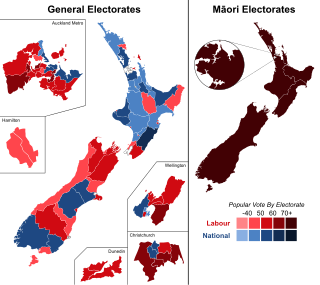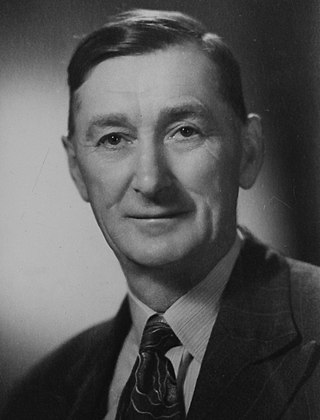Related Research Articles

The 1978 New Zealand general election was a nationwide vote to elect the 39th New Zealand Parliament. It saw the governing National Party, led by Robert Muldoon, retain office, but the opposition Labour Party won the largest share of the vote. Reorganisation of the enrolment system caused major problems with the electoral rolls, which left a legacy of unreliable information about voting levels in this election.

The 1972 New Zealand general election was held on 25 November to elect MPs to the 37th session of the New Zealand Parliament. The Labour Party, led by Norman Kirk, defeated the governing National Party.

The 1911 New Zealand general election was held on Thursday, 7 and 14 December in the general electorates, and on Tuesday, 19 December in the Māori electorates to elect a total of 80 MPs to the 18th session of the New Zealand Parliament. A total number of 590,042 (83.5%) voters turned out to vote. In two seats there was only one candidate.

The 1919 New Zealand general election was held on Tuesday, 16 December in the Māori electorates and on Wednesday, 17 December in the general electorates to elect a total of 80 MPs to the 20th session of the New Zealand Parliament. A total number of 560,673 (80.5%) voters turned out to vote.

Rotorua is a New Zealand parliamentary electorate, returning one Member of Parliament to the New Zealand House of Representatives. It was first established in 1919, and has existed continuously since 1954. The current MP for Rotorua is Todd McClay of the National Party, who won the electorate in the 2008 general election from incumbent Labour MP Steve Chadwick.
Taranaki was a New Zealand parliamentary electorate that existed for three periods between 1881 and 1996. It was represented by nine Members of Parliament.
King Country was a New Zealand parliamentary electorate. It existed from 1972 to 1996 and was represented by Jim Bolger of the National Party for those 24 years.
Gisborne is a former New Zealand parliamentary electorate. It existed from 1908 to 1996, and it was represented by 12 Members of Parliament.

Patrick Kearins was a Member of Parliament for Waimarino, in the North Island of New Zealand.
Waikaremoana is a former New Zealand Parliamentary electorate, from 1984 to 1996. During the four terms of the electorate's existence, it was held by National's Roger McClay.
Ruahine is a former New Zealand parliamentary electorate, from 1972 to 1978.
Tarawera is a former New Zealand parliamentary electorate, from 1978 to 1996. It was represented by two members of the National Party.
Stratford is a former parliamentary electorate, in Taranaki, New Zealand. It existed from 1908 to 1946, and from 1954 to 1978. It was represented by six Members of Parliament.
Waitotara was a New Zealand parliamentary electorate in South Taranaki. It existed from 1881 to 1893, and again from 1978 to 1996. It was represented by four Members of Parliament.
Patea is a former New Zealand electorate in south Taranaki. It existed from 1893 to 1963.
Wanganui and Rangitikei is a former parliamentary electorate that existed from 1853 to 1860. It was represented by two Members of Parliament.
Waitomo was a parliamentary electorate in the Waikato region and the King Country of New Zealand, from 1919 to 1972. The electorate was represented by four Members of Parliament.
Temuka was a parliamentary electorate in the Canterbury region of New Zealand from 1911 to 1946. The electorate was represented by four Members of Parliament.
Hawera was a parliamentary electorate in the South Taranaki District of New Zealand from 1896 to 1908. It was represented by two Members of Parliament over the four parliamentary terms of its existence.
Taumarunui was a parliamentary electorate in the King Country in the Manawatū-Whanganui region of New Zealand from 1908 to 1919. The electorate was represented by two Members of Parliament.
References
- Cottrell, S. P. (1974). Parliament and Conscience: 1950–1972 (MA). Christchurch: University of Canterbury.
- Foster, Bernard John (22 April 2009) [1966]. McLintock, A. H. (ed.). Second Ballot System (1908–13). Wellington: An Encyclopaedia of New Zealand . Retrieved 7 August 2013.
- Freer, Warren (2004). A Lifetime in Politics: the Memoirs of Warren Freer. Wellington: Victoria University Press.
- Logan, Mary (2008). Nordy, Arnold Nordmeyer: A Political Biography. Wellington: Steele Roberts.
- McRobie, Alan (1989). Electoral Atlas of New Zealand. Wellington: GP Books. ISBN 0-477-01384-8.
- Taylor, B. S. (1974). The Expulsion of John A. Lee and its Effects on the Development of the NZ Labour Party (MA). Christchurch: University of Canterbury.
- Wilson, James Oakley (1985) [First published in 1913]. New Zealand Parliamentary Record, 1840–1984 (4th ed.). Wellington: V.R. Ward, Govt. Printer. OCLC 154283103.
- Norton, Clifford (1988). New Zealand Parliamentary Election Results 1946–1987: Occasional Publications No 1, Department of Political Science. Wellington: Victoria University of Wellington. ISBN 0-475-11200-8.